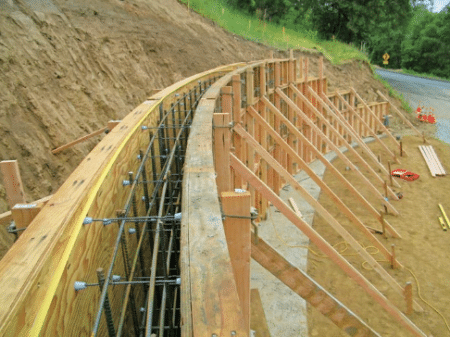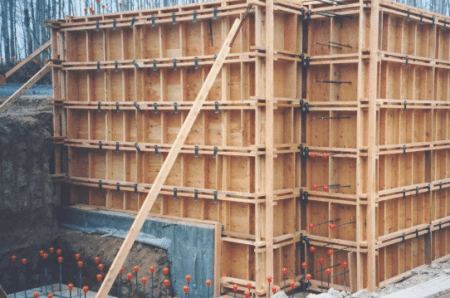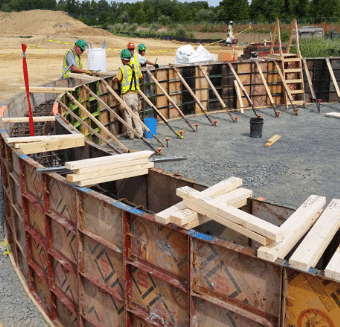Concrete Forms – Types and Selection of Concrete Forms
Concrete forms can be defined as a solid barrier that helps to hold the fluid concrete in place until it hardens and acquire a particular shape. The concrete takes the shape of the form or the mold in which it is contained. Now new concrete form systems are developed that provides additional properties like insulation, surface patterns and effects to the concrete cast.
Here, the types and the criteria for the selection of formwork are explained.
Table of Contents
Types of Concrete Forms
The different types of concrete forms used in concrete casting are:
- Wooden Forms
- Insulated Concrete Forms
- Foam Concrete Forms
- Concrete Wall forms
- Steel Forms
1. Wooden Forms
Wooden form is the basic and the most conventional type of concrete form. It is employed mainly for concrete casting that does not exceed 6 inches of height.
The wooden form types consist of wooden boards. These are either nailed or screwed together to the desired mold or formwork shape. Special leveling devices are used to properly level or slope the form based on the requirement.

Fig.1.Wooden Concrete Forms; Image Courtesy: http://gatesconcreteforms.com
In order to cast concrete with curves or any sort of free-form designs, thinner cross-sections are employed to make the form. Before pouring concrete, the inner surfaces are applied with low-grade oil or any form releasing agent so that concrete does not stick to the surfaces.
If properly cleaned and maintained, these forms are suitable for multiple uses.
2. Insulated Concrete Forms
The insulated concrete forms (ICF) compromises of hollow blocks made of insulating material that is fit together like building blocks as shown in figure-2.
These systems are constructed on the foundation slab. This forms a part of the foundation and the wall systems. Reinforcement is placed within these blocks and filled with concrete of required slump and cast.

Fig.2.Insulated Concrete Forms (ICF)
The form and concrete are placed like a sandwich. This system provides high energy efficiency. Removal of forms is not necessary by implementing ICFs. Once the concrete is filled it need not be removed.
3. Foam Concrete Forms
These type of forms follows non-traditional methods. Here, the concrete is poured upside down, so that a concrete of desired finish is obtained. These forms are either made from melamine, acrylic glass or laminated board. These forms create negative spaces that bring an artistic look to the final concrete cast.4. Concrete Wall Forms
These are pre-manufactured forming systems used to cast large area walls, foundations and piers. These systems are either made with engineering wood with a steel framing. This is also made completely with steel.
These individual elements are attached together by pins or latches as shown in figure-3. Ties are used in these formworks to hold the reinforcement in place when the concrete is poured.

Fig.3.Concrete Wall Forms; Image Courtesy: igknighttec.com
Concrete wall form sections come in different, sizes and shapes. There are also manufacturers who provide custom size wall forms based on the requirement of the project.
5.Steel Concrete Forms
These are concrete forms made of steel. If properly maintained and used, the consistency of steel forms can be obtained even for 2000 work cycles. This hence, compared with wooden concrete forms is a better long-term solution in construction.

Fig.4.Steel Concrete Forms; Image Courtesy: www.whartonhardware.com
The steel forms do not absorb moisture from the concrete placed hence reducing errors observed after removing the concrete forms.
Selection of Concrete Forms
When coming to the decision of choosing concrete forms, it is dependent on “where” and “how “the system is used. The concrete form selected for a project is dependent on the:
- Pour Size
- Pressure on the Form
- Weight on the form
- Type of Compaction
- Amount of concrete to be retained
In detail, there are few key elements that are considered while selecting concrete forms, which are explained below:
- The concrete forms selected can be either owned or rented. The cost of owning and its long-term use must be analyzed before buying it. If it is better to rent the form, then form type which is easily available and economical is chosen.
- The experience with a particular type of form affects the choice of form. No production loss is expected if a form system is chosen that is more familiar to the workers. Without proper training of a new form system, loss is expected.
- In terms of aesthetics, steel forms provide a clean finish with fewer bug holes on the casted concrete surface compared with wooden forms.
- In providing tolerances steel forms are a better choice compared with other types. Steel forms have intrinsic stiffness and do not absorb moisture.
- For low height structures, wood forms are the best choice. For tall forms of 20ft height steel forms with extra bracing and supports are the best choice compared to wooden forms.
- For casting concrete with straight, curve or several offsets, and abrupt turns, steel form are an efficient choice. Thin wooden forms can be used if cost is an issue.
Comments
Post a Comment